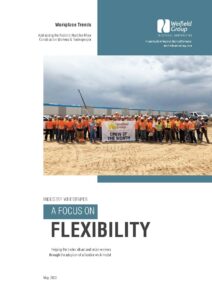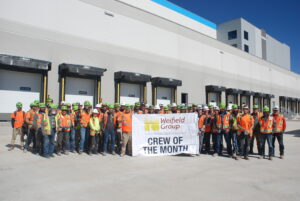IEC 2023 Emerging Leaders Report Project Findings to Assist IEC Member Contractors
By IEC Staff The IEC Emerging Leaders Program is a six-month leadership development experience for professionals in the electrical and systems contracting industry. Each year, six to ten individuals are selected to form a cohort class that participates in skills development workshops, networking opportunities, leadership exercises, and project development experiences. The culmination of the experience […]
The post IEC 2023 Emerging Leaders Report Project Findings to Assist IEC Member Contractors appeared first on IEC Insights.
By IEC Staff
The IEC Workforce Development Institute’s recent research report, Understanding Barriers to Entry in the Electrical Trade, included U.S. Bureau of Labor Statistics that show an estimated 73,500 electrical job openings are projected year over year for the next 10 years — outpacing supply. Just under 70% of the IEC electrical contractor members surveyed for this study feel the supply of electrical apprentices is NOT sufficient to support their businesses.
So, what to do?
IEC contractor member Weifield Group Electrical Contracting, headquartered in Centennial, CO, has an idea. The company introduced an industry whitepaper this year, A Focus on Flexibility: Helping the Trades Attract and Retain Workers through the Adoption of a Flexible Work Model. In the course of their research — both internal and external — the company found that “perhaps the largest source of dissatisfaction with construction involves workers’ perception of how the industry’s demanding schedule may affect their day-to-day lives.” 
Weifield Chief Revenue Officer Karla Nugent feels the time is right for out-of-the-box thinking. Weifield continues to grow each year so paying attention to all things recruitment and retention is top of mind at all times.
“Today’s potential employees and apprentices think a bit differently than years back,” Karla says. “They are willing to work hard, but they also expect employers to hear them, to invest in them, to care about them, and they want to know that their work will make a difference in this world.”
The Weifield study quotes these sources:
- LinkedIn: More job seekers (63%) said work-life balance was a top priority when considering a new role than those (60%) who said excellent compensation and benefits.
- U.K. Flexible Schedule Case Study: A pilot program to test flexible work schedules on job sites conducted by four major construction firms in the U.K. found that workers’ sense of wellbeing increased, while overtime hours decreased, without negatively impacting project schedules or budgets.
- Weifield Testing: Weifield began its flexible work testing with some of its rural jobs, where workers had long commutes to the job sites. Then a model of rolling 4/10s was tested on larger job sites where crew members all work four, 10-hour days per week with overlapping crews providing worker presence all five days of the work week. Leadership saw improvements in morale and productivity, without any impact on safety.
Weifield leadership knows a shift to flexible work must be an industry-wide effort to be successful.
 “We advocate for flexibility throughout the industry,” Karla states. “I can add flexible work and sure, that’s going to be a benefit to us, but we really do need clients, general contractors, partners, and subcontractors to be involved to generate an industry-wide shift.”
“We advocate for flexibility throughout the industry,” Karla states. “I can add flexible work and sure, that’s going to be a benefit to us, but we really do need clients, general contractors, partners, and subcontractors to be involved to generate an industry-wide shift.”
She has spoken with numerous general contractors and project developers who have been receptive of a flexible work model.
“I asked some developers how they would respond if a general contractor came to them and said, ‘We’re going to deliver your project in the timeframe that you need to open. We’re going to maintain the budget and we’re going to maintain quality. But we’re going to focus on a four-day work week for the benefit of our employees to increase morale and craft engagement,’” Karla reports. “’Is there a reason you would not approve that schedule?’”
Overwhelmingly, the responses she received from developers were that they just want to get the work done. If that can happen with a different schedule that helps contractors have higher engagement and happy employees, they feel it’s a win for them as well.
You can read the Weifield study here, including a step-by-step plan on implementing a flexible schedule pilot program, case studies, and employee statements.
Company Recruitment and Retention Efforts
The flexibility initiative goes hand-in-hand with Weifield’s ongoing efforts to care for its employees. Karla says Weifield’s values statement focuses on four areas — the company’s PACT with their employees.
People
This is the company’s #1 value, which it demonstrates through more than competitive salaries. The company offers assistance / programs for physical (stay well); emotional (be supported); fiscal (plan my future); knowledge (grow my career); social (enjoy my work); recognition (be rewarded).
“Our employee assistance services have really grown over time to a place where we employ an external company that focuses on how to meet needs that we’re not trained on like a family member talking about suicide or dealing with the estate of parents who have died,” Karla says. “This allows our employees to talk with professionals who can help them solve problems that, of course, impact them on the job.”
 Advance Process
Advance Process
Developing, communicating, and improving our processes to achieve quality, training, and consistency, sharpen our focus, and lay the groundwork for continuous improvement.
“I sit on the Colorado Business Round Table executive board, which is a business round table with many of the large Colorado employers where we look at workforce trends and data,” Karla says. “One program we’re creating with many partners is a construction-specific associates degree with the Colorado community college system. It’s a customized 60-credit degree that builds upon existing apprenticeship curriculum, for all trades, not just electrical.”
Community
Weifield defines this company value as ‘Giving our time and financial resources to worthy causes in order to make a meaningful difference in the places we live, work, and play.’ Weifield partners with 100 non-profits focused on developing people in four key areas: head of household; women and children; health / the less fortunate; and the U.S. military.
“This helps us with the big purpose piece that employees are asking for from employers,” Karla says.
Trusting Relationships
This is defined as ‘Building our business through trusting relationships and caring concern for the well-being of our clients, vendors, and all other stakeholders.’
“We developed a Weifield Council into our business in 2008, to talk regularly with our employees and ask what’s working and what’s not working,” Karla explains. “The Council gathers information — and leads improvement initiatives…maybe it’s a new benefit, a new training program, fun events, or contests.”
A Final Word
The Weifield flexibility report closes with this statement: “If the industry is willing to explore new ways of recruiting and retaining talent, collectively, we can ensure the wellbeing and performance of individuals and teams while protecting the future of our industry.”
Traction: Get a Grip on Your Business
Karla talks highly of this book by Gino Wickman, creator of the Entrepreneurial Operating System (EOS®). Per Gino, EOS is a “holistic system that helps leaders run better businesses, get better control, have better life balance, and gain more traction with the entire organization advancing together as a healthy, functional, and cohesive team.”
“We follow the best practices and operating system of this book, as do many larger companies that need a system so that they don’t grow into silos,” Karla says. “It helps you take your vision for your company — people, process, data — and wraps a system around it to identify and solve issues while providing improved communications. It helps us learn how to better communicate with and engage our employees.”
The post Weifield Group Advocates for Industry-Wide Adoption of Flexible Work Model appeared first on IEC Insights.


